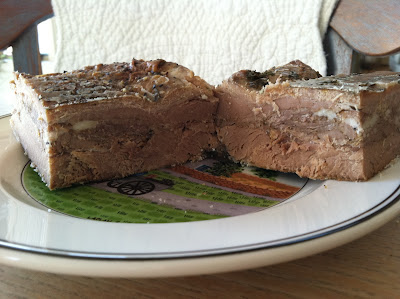This year following Michael Ruhlman's recipe and with the encouragement of the Charcutepalooza movement, I just finished corning my second brisket and am happy to report the recipe is not only incredibly easy but superlative to any supermarket pre-corned beef. All you need is a week's forethought for the brining and you are home free.
But St. Pat's is not only about the corned beef. Of course there is lovely skillet bread and clam pie but when you get right down to it, it's all about the cabbage for me. I love cabbage. Not my great aunt's cook it til the sulfur smell inhabits every corner of her Woodside apartment building. Lovely pale green, crisp but not snappingly so, cabbage. And a St. Patrick's Day meal to me means combining cabbage with the vegetable no Irish family could survive without - the potato. Together they make the heaven known as Colcannon.
So follow Michael Ruhlman's recipe for corning the brisket. When cooking the actual corned beef though, I recommend the following - and serve it with Colcannon and spinach. No idea why spinach, just always had spinach on St. Patrick's day. Maybe because it's green? And a green and white cookie for dessert couldn't hurt....
Corned Beef and Colcannon
For the Corned Beef
1 5lb. corned brisket (hopefully home-corned)
1 onion, quartered
2 carrots, cut into chunks
2 parsnips cut into chunks
3 sprigs rosemany
1 dried chile, I use chile d'arbol
stalks of a fennel bulb
2 tbsp. pickling spice - make Ruhlman's recipe and keep extra on hand
1 tbsp. fennel seed
For the Colcannon
4 lbs. Yukon Gold potatoes
1/2 cabbage head, cut again in half
3 leeks, cleaned and slice lengthwise into quarters and then across in 1/4 inch slices
4 scallions, sliced cross-wise, white and clean green parts included
2 cups milk, half and half, cream in whatever proportions you can justify1 stick butter, plus 1 tsp.
1 glug olive oil
1 tbsp. fresh parsley, minced
Salt and freshly ground pepper, to taste
1. Preheat oven to 300 degrees. Place brisket in a pot large enough to allow it to lay flat. cover with water by 2 inches. Add remaining ingredients, cover and place in the oven for 3 to 3 1/2 hours. When a corner easily slices off - you're done.
2. Remove pan from the oven, uncover and let cool in the brine for about 30 minutes. Remove from the brine to a platter and let cool until colcannon is done. Retain about a quart of cooking solution for moistening the sliced meat and for re-heating leftovers.
3. In a small skillet, saute the leeks in 1 tsp. butter and a parsimonious glug of olive oil until the leeks are translucent. Add the scallions, stir for one minute. Remove from heat and set aside.
4. When you remove the meat from the oven, peel the potatoes and cover with salted cold water in a stock pot. Add the two cabbage chunks. Place over high heat for 20 minutes but keep an eye on it, you don't want to cook the cabbage to death. Remove the two pieces of cabbage, they should still be firm and pale green and place on a cutting board.
5. Continue cooking the potatoes until a knife easily slides through. Drain the potatoes and return to the stock pot. Reduce heat to its lowest possible setting. Sprinkle the potatoes with salt to taste. Keep an eye on it so the potatoes don't scorch. You want the liquid in the boiled potatoes to evaporate.
6. Combine the milk mixture and butter in a heat-proof vessel and microwave for two minutes. Stir and, if necessary, microwave for another two minutes.
8. Thinly slice the corned beef against the grain and serve with just enough cooking liquid to moisten the sliced meat. Horseradish sauce is excellent on the side. If you are too lazy to make your own horseradish sauce, Boar's Head is acceptable but not optimal. Serve with the colcannon and spinach. Sprinkle with parsley, yes, because it's green.
And for dessert....



























